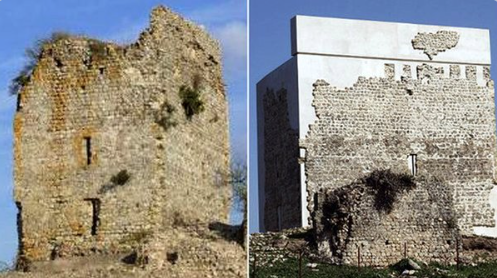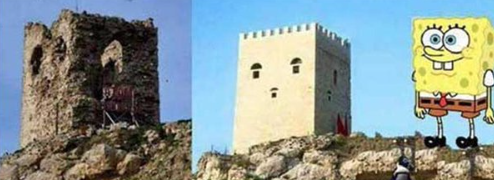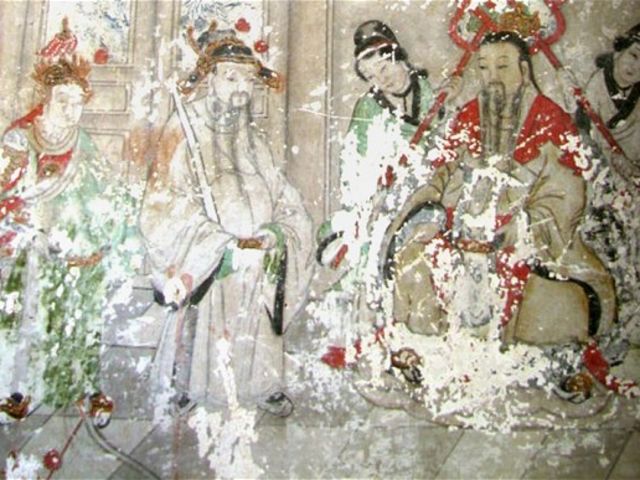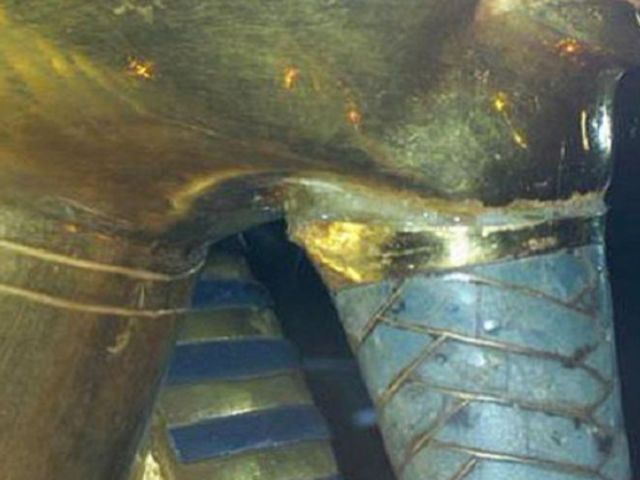The U.K. is covered in old buildings and ruins. Deciding which to fully or partially restore, which to manage to prevent further degradation and which to let disintegrate away is a complicated process depending on the structures uniqueness and importance to history and the arts as well as expense.
The rules are very strict and it’s well known that those who choose to purchase a dilapidated property will have to restore it in the manner that it would have been built at the time using the same materials and techniques, even if this is five times more expensive than cheating by doing it a modern way. Nothing must compromise the original design and structure of the building or work of art and several properties have been left to fall apart because the proper materials proved to be too expensive and cumbersome for the current owners.
There are very good reasons for this. Art, buildings and monuments that have Listed status are to be preserved as they were recorded, not how some millionaire sees fit to restore it combining 13th century and 21st-century technology. The main way to get around this is to renovate a building using temporary though very long lasting construction work.
If you have a castle or old church and you can’t afford to repair it entirely or if you can’t see yourself living the life of someone 500 years ago then sometimes it is possible to build on extensions using glass, steel or other modern materials and so not only have somewhere modern to live but also sometimes enhancing the uniqueness of the original structure in such a way that in 200 years time when technology has improved, future generations can decide what to do then.
Victorians were very good at almost everything but they sometimes got things wrong when restoring buildings and would use modern fangled technology such as manmade cement or plaster that though was revolutionary cheaper to apply and looked great from the outside, didn’t take into account the tendency for natural stone and materials to sweat, leaving the unseen structure to rot away.
If remedial work is undertaken, then it has to be overseen by some highly specialised and talented designers. Just last week at my visit to Hampton Court, I mentioned some wall paintings that were suffering from humidity and even after 20 years of studies, a firm plan has not yet been reached over how to restore and protect them in the future. This might seem over protective but once something is ruined then it is ruined for good. The alternative to this can, unfortunately, be seen in several awful repair jobs around the world.
This week the restoration of the Spanish castle Castillo de Matrera was widely ridiculed and reviled in equal measure.

What was a ruined old fortification albeit one with heaps of charms and no doubt a good measure of history looks like it has been knocked down with some of the original bricks stuck onto some ugly concrete. I can’t see that happening here thankfully but sadly Spain has a long history of treating its vast heritage less than ideally.
Residents told Spain’s La Sexta channel they weren’t impressed, or, as one man put it: “They’ve got builders in rather than restorers and, like we say round here, they’ve cocked it up.”
“Comments aren’t really necessary when you’ve seen the photographs. Foreigners have written to us saying they can’t understand why these follies – better described as heritage ‘massacres’ – still go on. And that is indeed what they are.”
Twitter, characteristically, has been rather more blunt. “It’s pretty clear that restorations of works of art in Spain always end up worse than the original.”
Several other castles around the Mediterranean have coped only marginally better such as that in Turkey nicknamed the Spongebob Square Pants Castle, which at least kept a vague castle-like appearance.

It’s not just 21st-century castle restorers that seem to run into problems. I once visited the fantastic Citadel of Qaitbay in Alexandria, Egypt. The original castle was built over 1200 years ago out of the ruins of the legendary Lighthouse of Alexandria and was once the most formidable castle in Egypt. 19th and very early 20th century renovations, however, seem to have taken inspiration of a traditional British Sandcastle which I suppose is quite apt in Egypt but it means the original character is lost and replaced by a Disneyland-like castle. Standing on the battlements with the Mediterranean crashing against the rocks below was still kind of cool though!

It’s easy to forget when looking at old buildings and frescos around the world that at one time they would likely have been painted in possibly garish styles for modern tastes. The world was dark and grim and few could afford bright paints. Whether it is the Sphinx or a quiet English church, centuries ago they were brightly painted. Restoring frescos can take a generation of careful, studious work. If you want to see the wrong way of doing it, then it might be worth visiting Chaoyang, China where a priceless Qing Dynasty fresco was repaired on the cheap. The garish colours may be appropriate but the actual details were ignored.


Just last year one of the most famous objects in the world was restored in the most blundering way when the famous beard on the golden burial mask of Tutankhamun was re-attached using something not much better than superglue. By better, I mean in terms of suitability for the job at hand not for its lack of adhesive properties.


As a curator commented, “Unfortunately he used a very irreversible material, Epoxy has a very high property for attaching, and is used on metal or stone – but I think it wasn’t suitable for an outstanding object like Tutankhamen’s golden mask.”
D’oh!
There can only be one winner in this competition. Perhaps taking inspiration from the Italian restoration on the 750-year-old fresco ‘Tree of Fertility’ in which the phalluses that sprouted from the branches have been painted over, rather forgetting the whole ‘Fertility’ feel that the original had going for it.
We finish this countdown where we started it, back in Spain with the all-time classic The Ecce Homo.


Cecilia Giménez, 83, attempted to restore the century-old ‘Ecce Homo’ fresco of Jesus crowned with thorns in the Roman Catholic Church of Santuario de la Misericordia, in the small town of Borja, Spain back in 2012.
Although authorities initially suspected vandalism, Mrs Gimenez eventually came forward to confess she had attempted to restore her “favourite” painting after she became upset at the flecked and peeling paint.
In a twist of fate, the action – thought to have spelt the end for Elías García Martínez artwork – has inadvertently provided a massive tourism boost for the 5,000-strong town. Since Mrs Giménez ‘restoration’ hundreds of thousands have visited the town in order to see the painting on the walls of the small church – which charges a euro to enter – behind a clear plastic screen.
Surely this is the most awful and childish restoration of all time which somehow turned Jesus into a monkey. Still, God works in mysterious ways!
I thought. The fecundity tree in massa marittima was done well. I agree with the rest of what you say.
LikeLiked by 1 person
Did you see it after they removed all the phallic symbols?
LikeLike
Great post, some of those restorations are outrageous! 🙂
LikeLiked by 1 person
They are! How did they ever think it was a good idea!
LikeLiked by 1 person